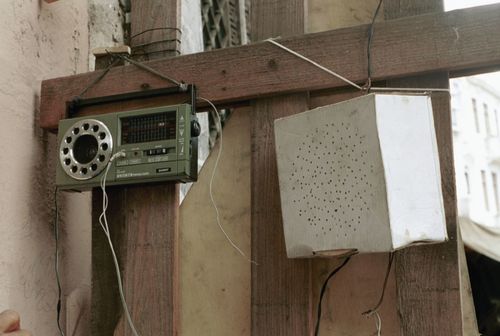Streets of invention
The streets of Rio de Janeiro in Brazil are rich with Barlow’s kind of inventiveness with humble materials, but driven by urgent practical requirements. The artist Gabriela de Gusmão Pereira has documented this everyday creativity. If Barlow uses impoverished materials deliberately, then the poor of Rio have no choice. They live on what Gusmão calls ‘Invention Street’, making do as best they can. Gusmão has photographed and drawn a whole series of ‘inventions’: a sound system with a cardboard box speaker (figure 4); a resting place made of two broken seats; a portable sound system on a tricycle with its own light show; a portable bed for a homeless person. People who live on the streets have to adapt and appropriate. Artists can aspire only to the integrity of these improvisations [45,46].

Figure 4. Gabi Gusmão, Radio and Soundbox made by Célia Regina, photographed in Rio de Janeiro.
The kinds of objects and arrangements that Gabi Gusmão photographed come close to what are known in Brazil as gambiarra, a term meaning contraption, gadget, making do. Gambiarra may be defined as an improvised amendment to an object, normally combining another object. They are comparable to prototypes but they are both provisional and final, an unlikely mend, almost an illustration of a problem. If Gusmão captured a needs-must economy, there is now a whole world of gambiarra images on the Internet that travel like memes and, I suspect, are more to do with competitive playfulness than dire necessity: a soup spoon is made from a fork and the base of a polystyrene cup; an electric drill is combined with a handwhisk; a bike is adapted so that its front wheel incorporates a shopping trolley; gaffer tape is used to make countless rough but inspired mends. Some gambiarra have no real usefulness but make a political point about consumerism as visual contributions to a contemporary luxury debate. A child’s globe is taped to a car dashboard as a joke Satnav. An apple is taped to the lid of a cheap PC [47].
Gambiarra culture has had an impact on design in general. For instance, the Spanish designers El Ultimo Grito create handsome tables made from waste cardboard and sticky tape coated in brightly coloured fibreglass. The Campana Brothers’ Favela chair made of hundreds of pieces of waste wood is, as its name suggests, directly inspired by improvisatory shantytown construction in Brazil. Ironically, the Favela chair is now produced commercially in short runs by the furniture company Edra, retailing at £4500 a chair. Both these two delightful objects—El Ultimo Grito’s British Racing Green Table and the Campana Brothers Favela chair—reek of romanticism concerning poverty and the improvisations that poverty inspires. There is something troubling about a design situation where the poor of the globe become source material for high-end design rather than designers devoting time to designing low-cost products for the poor.
The Royal Society Publishing, UK

PROFILE
The Royal Society has published ground-breaking research for more than 350 years, including pioneering papers by Isaac Newton, Charles Darwin and Rosalind Franklin. Our international, peer reviewed journals continue to publish high quality research across the full range of science and provide an excellent author service.
